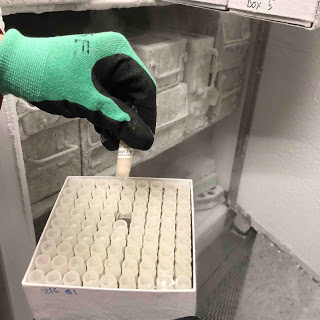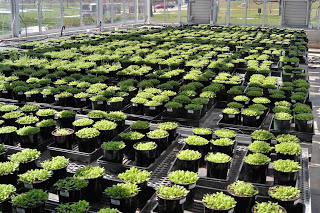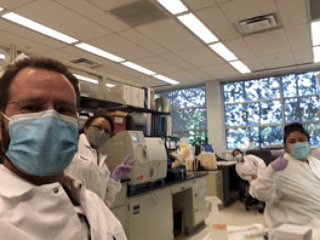26 Aug How are living stock collections managing during the COVID-19 pandemic?
Earthquakes. Fires. Floods. Tornadoes. Drought. Hurricanes. Power outages. Funding fluctuations. Sudden loss of primary personnel. Living stock collections have plans and procedures to mitigate the impact of these types of emergencies. For example, many publicly available cryopreserved collections have deposited copies of their collection at the USDA National Laboratory for Genetic Resource Preservation (NLGRP) in Fort Collins, Colorado, where they are stored hundreds of miles away in liquid nitrogen tanks, safe from earthquakes, floods, fires and other disasters.
Then along came 2020. Few collections planned for a global pandemic. The COVID-19 pandemic caught many of us by surprise, with little advance planning in place to cover crucial management duties with adequate PPE and while social distancing, or for potential supply disruptions.
Different organisms require different amounts and types of upkeep. Organisms such as bacteria, molds, yeasts, viruses, some species of microalgae, tissue cultures, and some mammalian embryos can be cryopreserved or lyophilized. Curators of these types of collections are lucky these days: as long as the refrigerators or freezers are functional, the stocks will be fine. Curators of other types of organisms are less lucky: these are the organisms that must be propagated as living organisms. This has become much more complicated during the COVID-19 pandemic.
NOTE: Scroll to the end of this post for a list of Recommendations based on lessons learned.
Here’s examples of how many different kinds of collections are managing during the current COVID-19 pandemic.
Kyria Boundy-Mills, curator of the Phaff Yeast Culture Collection at the University of California Davis: “Our collection falls into the “lucky” category: the COVID-19 pandemic does not threaten the viability of our stocks. Until about 20 years ago, the collection was preserved as active cultures on oiled agar slants, so we had to transfer about 50 strains per week to fresh media. They are now all cryopreserved and/or lyophilized, so they will be fine as long as the freezers are functional, which we confirm online via the freezer alarm system, plus a brief visit to the lab a few days per week. Also, we have a copy of the collection preserved at the USDA NLGRP facility in Fort Collins, Colorado. I sleep better at night knowing that a copy of the collection is far away from the California wildfires, which came within 15 miles of the UC Davis campus this month.”

Cryopreserved yeast cultures at the Phaff Yeast Culture Collection, UC Davis, photo by Kyria Boundy-Mills
Stephanie Greene, Microbe Curator at NLGRP: “The USDA NLGRP falls into the “lucky” category as well. At the start of the pandemic, the USDA Agricultural Research Service deemed that keeping plants, animals and microbes alive was an essential task. Although much of the staff at the lab is teleworking, staff such as Greg Holman have been going into the building daily to check that our storage facilities are keeping our collections of seeds, livestock (stored as semen) and microbes alive. We also continue to receive new collections.”
Emma Knee, Associate Director at the Arabidopsis Biological Resource Center: “When The Ohio State University instituted a ramp-down of research activities in March, The Arabidopsis Biological Resource Center (ABRC) had more than 2000 live plants growing in their greenhouses. Although most resources distributed by ABRC are maintained either as cryo-preserved cultures or seed lines stored in dehumidified cold rooms, many of these plants represented new donations for which we did not yet have seeds in long term storage. Fortunately, the Arabidopsis life cycle is relatively short and a single staff member was able to harvest all the seed lines in a matter of weeks. Once harvested and cleaned, seeds can be preserved at low temperature and relative humidity for decades. A sample is also sent to the Nottingham Arabidopsis stock center in the UK where the collection is mirrored – as we have learned, storage of a copy of the collection at a distant location can be crucial in an emergency.”

Arabidopsis growing in the ABRC greenhouses. Photo by James Mann, an ABRC curator.
David Nobles, the Curator of the UTEX Culture Collection of Algae at the University of Texas at Austin: “Although 50% of our algal species are cryopreserved and relatively unaffected by the COVID-19 pandemic, more than 1,500 strains must be maintained as active cultures that are maintained by regular serial transfers. Additionally, each month, the maintenance and distribution of strains requires the production of an average of 100 liters of diverse culture media, processing and disposing of large volumes of biological waste, cleaning and sterilizing thousands of pieces of glassware, and various other tasks related to facilities maintenance and strain distribution. The bulk of this work is normally done by several part-time undergraduate student research assistants and four senior staff members, approximately the equivalent of five to six full time staff equivalents. However, due to our campus COVID-19 mitigation program, which does not currently allow undergraduate student to work in laboratories, and other factors related to the COVID-19 pandemic, all of the work of operating the Collection is on the shoulders of myself and one other staff member for at least the next few months.”
Michael Lomas, Director of the National Center for Marine Algae and Microbiota at Bigelow Laboratory for Ocean Sciences: “The NCMA collection is split roughly 50/50 between the cryopreserved portion, and a portion that needs to be serially transferred. While on the surface, the cryopreserved portion might have been viewed as stable, the relative remoteness of Bigelow Laboratory in Maine amplified concerns about supply chain disruptions – in this case the supply of liquid nitrogen. Not knowing if or how long any disruptions might happen, we had to quickly enter a stockpiling mode for consumables from liquid nitrogen to all the test tubes needed for serial transfers. While in the end there were no real supply chain disruptions, just delays, we did need to move on to completely revamping what a ‘work week’ looked like. Luckily, the State of Maine allowed our staff to be considered ‘essential’ so we could come into the lab to work, but the need to be responsive to staff safety resulted in setting up shifts for our curators so that they could keep transferring cultures, just not side-by-side as normal.”
Manzour Hazbón, Bacterial Collection Scientist at ATCC: “The COVID-19 pandemic has resulted in numerous changes from normal operations. ATCC regularly produces biological materials needed by the research community. During the first half of 2020 the focus at ATCC shifted to coronavirus and respiratory pathogens and a large number of new and existing products essential for the pandemic response including: standards for clinical laboratories, reference strains and diagnostic assays were produced. Many of these products are part of the infectious disease programs ATCC manages for government contracts. The increasing COVID-19-related production activities resulted in a redirection of the focus of many lab personnel to SARS-CoV-2-related activities. Similar to other companies, ATCC delegated some of the workforce to function remotely. However, the laboratory, quality control, shipping, receiving and other logistics teams continue to work onsite under very controlled measures consistent with CDC and the Virginia Occupational Safety and Health guidelines.
“In the laboratory, ATCC imparted careful coordination of onsite activities to minimize the risk of exposure between employees. This included facility engineering controls, social distancing and the use of personal protective equipment. The schedules for onsite personnel were staggered throughout the day in order to limit the number of biologists that could work in the same room at one time. Social-distancing between employees is further encouraged through virtual laboratory and other team meetings.”

Manzour Hazbón and part of his Bacteriology team working (socially distanced) at ATCC, photo by Manzour Hazbón
Renee Araiza, Assistant Director, Mutant Mouse Resource and Research Center, University of California Davis: “The MMRRC at UC Davis has culled back live colonies to minimal breeder pairs to maintain live stocks, and bred recently recovered stocks to maintain minimally, all others lines are cryopreserved as germplasm. Our vivarium and laboratory staff are rotating shifts to maintain minimal contact with other staff in their lab areas. While we had discontinued all of our product shipping for about 3 months, we did slowly start resuming shipments of mice and germplasm in late June. Our facility has policies in place per the UCD requirements for entering and working in the buildings, including temperature screening and using the daily QR online Screening Survey prior to arriving. Our customer service team is all working from home, with the exception of a few that now go in for shipping days. We still received regular deliveries of liquid nitrogen, the shelter in place did not affect that. We keep a cap on numbers of crates of mice and cryo shippers that go out, again to ensure safe distancing in the vivarium, laboratory, and offices.”
Cale Whitworth, Co-Director, Bloomington Drosophila Stock Center, Indiana University: Our collection of 77,000+ Drosophila strains, maintained in duplicate copy, cannot be cryopreserved and has required continuous care throughout the pandemic. Every 2 weeks, our staff of ~68 employees evaluate the health of and manually transfer live flies from each stock into fresh vials with enough food for the strain to live for about one month. This totals over 300,000 individual transfers each month. Because our operation is reliant on a large number of staff providing continuous care of animals, we had serious concerns about the possible impacts of COVID on the Center. In early March, we instituted cleaning, social distancing, mask requirements, and other standard COVID protocols. When Indiana University ended all non-essential operations, we also took advantage of newly unoccupied space to spread out our staff. So far, we have handled the crisis without any negative health consequences to our staff or the animals themselves. To avoid impacts of possible supply chain disruptions, we purchased 2 months of all ingredients used to make fly food. The largest impact has been on our finances. We stopped processing orders for 2 months as we deemed this a non-essential activity for the continued operation of the Center. The lack of income coupled with new expenses such as hazard pay for our staff and purchase of emergency supplies has resulted in a large deficit.
Take home messages:
Living stock collections have always been crucial for life science research. For example, collections of mice, viruses, and primates are now being used to understand disease, and develop diagnostic kits, treatments and vaccines for COVID-19. The formal quality control practices of public repositories ensure the researchers use reliable materials, and that their work is reproducible by other laboratories. Planning for disruptions and emergencies is an especially important part of collection management, especially collections maintained as actively growing organisms. The list of emergencies has expanded due to the COVID-19 pandemic.
Recommendations:
The strategies of maintaining collections will depend on the function of the collection and its maintenance needs, which vary based on the nature of the collection. Some common elements apply across collection types.
- Because the world may see other pandemics in the future, living stock collections need to add epidemics and pandemics to their list of possible events in their emergency plans.
- The epidemic/pandemic plan should include how to allow essential collection management work to continue while minimizing contact among workers, such as physical separation and working in shifts.
- Collections of non-pathogenic organisms that don’t normally need PPE such as face masks should consider maintaining an emergency supply of PPE to protect workers from infectious agents.
- Collection maintenance staff and administrators should know how to do all crucial maintenance activities, in case some personnel become unavailable.
- The emergency management plan should also consider supply chain disruption, such as liquid nitrogen and other consumable lab supplies.
- Developing preservation methods that are less labor-intensive, or that could be automated or performed remotely, should rise in priority.
- Secondary storage at the collection facility, as well as backing up collections at a distant location using a long-term storage format such as lyophilization or cryopreservation, should continue to be essential elements of emergency planning.
Authors:
Kyria Boundy-Mills, curator, Phaff Yeast Culture Collection, University of California Davis
Stephanie L. Greene, Microbe Curator, USDA, Agricultural Research Service, National Laboratory for Genetic Resource Preservation, Fort Collins, Colorado
Emma M. Knee, Arabidopsis Biological Resource Center, The Ohio State University
David Nobles, Curator, UTEX Culture Collection of Algae at the University of Texas at Austin
Michael Lomas, Director, National Center for Marine Algae and Microbiota, Bigelow Laboratory for Ocean Sciences
Rebecca Bradford, Principal Investigator for BEI Resources, American Type Culture Collection (ATCC)
Manzour H. Hazbón, Bacterial Collection Scientist, BEI Resources, ATCC
Cale Whitworth, Co-Director, Bloomington Drosophila Stock Center, Indiana University
Renee Araiza, Assistant Director, Mutant Mouse Resource and Research Center, University of California Davis
